«previous pageCOMMUNICATIONS CATEGORY
Honor Award
Michael Van Valkenburgh Associates: Reconstructing
Urban Landscapes
Anita Berrizbeitia, ASLA
publisher: Yale University Press
Project Statement
Michael Van Valkenburgh Associates: Reconstructing Urban Landscapes explores conceptual shifts in the firm’s work as they have moved away from a language-driven design logic to one that is largely operational, required of post-industrial sites. The essays collected in this volume focus on the intersection between the conceptual and the technological, on the negotiations that must be made between design intent and the realities of the site, in order to transform them into sustainable ecologies of lasting social significance.
Project Narrative
Concept Summary
This volume looks at landscape architectural projects of MVVA for urban sites that required extensive or complete reconstruction, a prevalent condition of practice in North America and Europe. The multiple restrictions and regulations associated with the restoration of post-industrial sites and their transformation into publicly accessible recreational spaces has shifted the locus of innovation, in many instances, from the formal to the procedural. Formal and experiential decisions are, as a result, delayed to the last phases of design and determined as much by new technologies, logistical constraints, and regulations as by visual and site criteria. The work presented in this volume is especially influenced by new technologies, by a site’s accumulated histories, and by a commitment to innovate in the face of increasing regulations and the demands of lengthy public processes.
The twelve projects chosen for this volume are presented chronologically to offer a sense of how the firm’s work has evolved as it responded to increasingly difficult conditions in marginal sites. Thus the essays begin with Mill Race Park in Columbus, Indiana, the first post-industrial commission of the firm in 1994, and end with the 2007 winning scheme “Portlands Estuary,” the largest ecological, remediation, and urban design proposal the firm has undertaken. The ten chapters that comprise the book were written by nine different authors, each chosen specifically for a project. With the exception of Chapters 8 and 10, which discuss three and two projects respectively, each chapter is devoted to the analysis of one project.
Interpretive Framework
Most writing about contemporary landscape architecture focuses on situating the work within larger cultural ideas, tracing the connection between those ideas and their physical manifestations on the land. While this places greatest emphasis on the cultural project of landscape, and rightly so, it typically discusses projects in their completed state. For this volume, the authors were charged with situating their writing at the intersection of the conceptual and the practical, that is, on the negotiations that must be made between design intent, the realities, often unanticipated, of the site, and the challenges of resisting unexamined codes and regulations in order to transform them into a meaningful design language. In other words, the interpretive framework places greater emphasis on the processes involved in the making of landscapes, rather than on its aesthetic reception once it is completed.
Book Format
Landscape architecture publications are typically of two kinds: the coffee table book — with many images and no critical writing — or the scholarly book, with mostly text and scant visual documentation. This book is a hybrid, it is both a scholarly look at a specific body of work, and at the same time a comprehensive visual documentation of that work. As such, it maintains the notion that landscape architecture is a field of intellectual and spatial concerns, with cultural as well as material content, in which rigorous scientific methods as well as the more elusive, yet precise, aesthetic sensibilities come together. This is hardly a contentious thing to say, yet it is rarely demonstrated in the recent literature of our discipline, which largely focuses on the diagrammatic and technical aspects of practices, at the expense of the visual. Although the prevalence of post-industrial sites in the firm’s portfolio of recent work has made MVVA’s practice increasingly technical, one could even say largely driven by data, MVVA resists surrendering design to the purely pragmatic, and strategically turns site limitations and regulations into a poetics of place, one that is influenced as much by the firm’s formal sensibilities as it is by a site’s unforeseen circumstances. This volume’s focus on the multiple aspects of the firm’s recent approach to landscape architecture — research, intellectual, material, and visual aspects — ultimately informs the book’s structure.
The book has a vertical format, 71/2” x 11”, hardcover, 320 pages, and 192 illustrations, four-color throughout.
Visual documentation
Each chapter in the volume is devoted to one project, and includes extensive visual documentation as well as a critical interpretation of the work. A photo essay of the built work made of four to six full bleed, double-page spreads, with no captions opens each chapter. The photo essays are meant to give the reader the opportunity to form an impression of the work, prior to reading its assessment. The images in the photo essay range in scale from aerial photography of the site — for context — to close up views that show the particular materiality of the project, providing comprehension of the work in all its scales. Within the body of the essay, a full range of graphic representation, from study models and concept sketches to precise plans and sections, construction details and additional photographs (in smaller format) reference the essays directly.
Intended Audience
The book is scholarly yet intended for a broad audience of designers, historians, ecologists, and environmentalists. Although rooted in the methods of landscape architectural criticism, its writing style was carefully crafted to be accessible to the non-specialist reader.
Distribution
The book is published by Yale University Press and will be distributed globally.
Project Resources
Editor
Anita Berrizbeitia
Essays by
Jane Amidon
Andrew Blum
Ethan Carr
Erik de Jong
Peter Fergusson
Rachel Gleeson
Linda Pollak
Elissa Rosenberg
Foreword
Paul Goldberger
Publisher
Yale University Press, New Haven, Conncecticut
Graphic Designer
Lorraine Ferguson, LF Design, New York
Photo Credit of Book Cover
Paul Warchol

Aerial photography included in the photo essay section at the opening of a chapter. (Photo: Alex MacLean, Landslides Photography)

close-up photograph shows a more experiential view, from the photo essay of the same chapter. (Photo: Elizabeth Felicella)

Well-documented technical research is included as a crucial stage in the construction of MVVA projects. (Photo: MVVA)
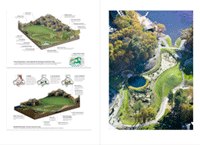
Cut-away models explain the remediation strategies and hydrology systems of a landscape restoration project. (Right photo: Alex MacLean, Landslides Photography)
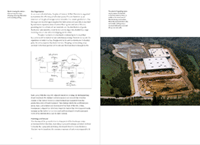
Documentation from the planning and construction stages of a project illuminate process. (Photo: Mack Scogin Merrill Elam Architects, Inc.)
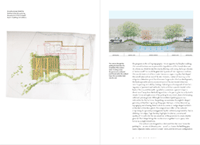
This spread shows the transformation from concept sketch to precise technical section through the parking lot and recharge area of the Herman Miller project. (Photo: Tony Gale)

Documentation of installation process at the Tahari Courtyards.

Documentation of ground material qualities at the Tahari Courtyards (left), and a preliminary sketch (right). (Photo Right: MVVA)
"This is much more than a monograph, it's a real case study containing some of the best drawings we've seen. To share this information is so generous and important to the profession."
— 2009 Professional Awards Jury
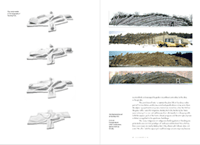
Evolution of study models on landforms (right), and the realization of an ice-water wall, from sketch, to full-size mockup at the quarry, to final installation (left).
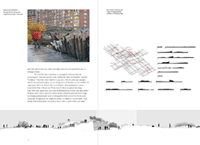
(Photo: left Elizabeth Felicella)

Diagrams showing consideration of larger site context and circulation patterns as driving factors in the design of a campus plaza. (Photo: MVVA)
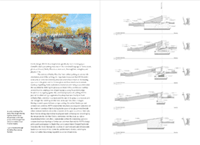
Construction details for the same campus plaza project. (Photo: MVVA)

A cross-section explaining relationships between the city, adjacent infrastructure, the site, and hydrology. (Photo: MVVA)
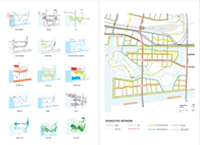
Diagrammatic analysis of the complex aspects examined in the Toronto Portlands competition proposal. (Photo: MVVA)

A rendering that describes the relationship between open space and urban setting as well as social use, used in the Toronto Port Lands competition. (Photo: MVVA)



